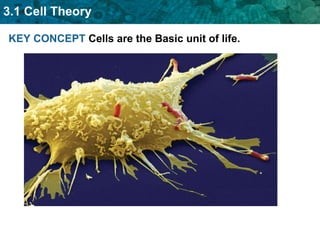
Unit 3 Cell Theory And Organelles
- 1. KEY CONCEPT Cells are the Basic unit of life.
- 3. The cell theory grew out of the work of many scientists and improvements in the microscope. Many scientists contributed to the cell theory. More was learned about cells as microscopes improved. The cell theory is a unifying concept of biology.
- 6. All organisms are made of cells.
- 8. Prokaryotic cells lack a nucleus and most internal structures of eukaryotic cells. All cells share certain characteristics.
- 9. Prokaryotic cells lack a nucleus and most internal structures of eukaryotic cells. All cells share certain characteristics. Cells tend to be microscopic. Bacterium (colored SEM; magnification 8800x)
- 10. Prokaryotic cells lack a nucleus and most internal structures of eukaryotic cells. All cells share certain characteristics. Cells tend to be microscopic. All cells are enclosed by a membrane. cell membrane Bacterium (colored SEM; magnification 8800x)
- 11. Prokaryotic cells lack a nucleus and most internal structures of eukaryotic cells. All cells share certain characteristics. Cells tend to be microscopic. All cells are enclosed by a membrane. All cells are filled with cytoplasm. cell membrane cytoplasm Bacterium (colored SEM; magnification 8800x)
- 12. There are two cell types: eukaryotic cells and prokaryotic cells.
- 13. There are two cell types: eukaryotic cells and prokaryotic cells. Eukaryotic cells have a nucleus. nucleus cell membrane
- 14. There are two cell types: eukaryotic cells and prokaryotic cells. Eukaryotic cells have a nucleus. Prokaryotic cells do not have membrane- bound organelles. nucleus organelles cell membrane
- 15. There are two cell types: eukaryotic cells and prokaryotic cells. Prokaryotic cells do not have a nucleus. nucleus organelles cell membrane
- 16. There are two cell types: eukaryotic cells and prokaryotic cells. Prokaryotic cells do not have a nucleus. Prokaryotic cells do not have membrane-bound organelles. nucleus organelles cell membrane cytoplasm
- 17. KEY CONCEPT Eukaryotic cells share many similarities.
- 18. Cells have an internal structure.
- 19. Cells have an internal structure. The cytoskeleton has many functions.
- 20. Cells have an internal structure. The cytoskeleton has many functions. supports and shapes cell
- 21. Cells have an internal structure. The cytoskeleton has many functions. supports and shapes cell helps position and transport organelles
- 22. Cells have an internal structure. The cytoskeleton has many functions. supports and shapes cell helps position and transport organelles provides strength
- 23. Cells have an internal structure. The cytoskeleton has many functions. supports and shapes cell helps position and transport organelles provides strength assists in cell division
- 24. Cells have an internal structure. The cytoskeleton has many functions. supports and shapes cell helps position and transport organelles provides strength assists in cell division aids in cell movement
- 25. Several organelles are involved in making and processing proteins.
- 26. Several organelles are involved in making and processing proteins. The nucleus stores genetic information.
- 27. Several organelles are involved in making and processing proteins. The nucleus stores genetic information. Many processes occur in the endoplasmic reticulum.
- 28. Several organelles are involved in making and processing proteins. The nucleus stores genetic information. Many processes occur in the endoplasmic reticulum. There are two types of endoplasmic reticulum.
- 29. Several organelles are involved in making and processing proteins. The nucleus stores genetic information. Many processes occur in the endoplasmic reticulum. There are two types of endoplasmic reticulum. rough endoplasmic reticulum
- 30. Several organelles are involved in making and processing proteins. The nucleus stores genetic information. Many processes occur in the endoplasmic reticulum. There are two types of endoplasmic reticulum. rough endoplasmic reticulum smooth endoplasmic reticulum
- 31. Several organelles are involved in making and processing proteins. (continued)
- 32. Several organelles are involved in making and processing proteins. (continued) Ribosomes link amino acids to form proteins.
- 33. Several organelles are involved in making and processing proteins. (continued) Ribosomes link amino acids to form proteins. Vesicles are membrane-bound sacs that hold materials.
- 34. Other organelles have various functions.
- 35. Other organelles have various functions. Mitochondria supply energy to the cell.
- 36. Other organelles have various functions. Mitochondria supply energy to the cell. Vacuoles are fluid-filled sacs that hold materials.
- 37. Other organelles have various functions. Mitochondria supply energy to the cell. Vacuoles are fluid-filled sacs that hold materials. Lysosomes contain enzymes to digest material.
- 38. Other organelles have various functions. Mitochondria supply energy to the cell. Vacuoles are fluid-filled sacs that hold materials. Lysosomes contain enzymes to digest material. Centrioles are tubes found in the centrosomes.
- 39. Other organelles have various functions. Mitochondria supply energy to the cell. Vacuoles are fluid-filled sacs that hold materials. Lysosomes contain enzymes to digest material. Centrioles are tubes found in the centrosomes. Centrioles help divide DNA.
- 40. Other organelles have various functions. Mitochondria supply energy to the cell. Vacuoles are fluid-filled sacs that hold materials. Lysosomes contain enzymes to digest material. Centrioles are tubes found in the centrosomes. Centrioles help divide DNA. Centrioles form cilia and flagella.
